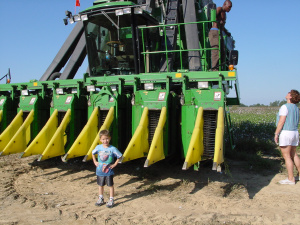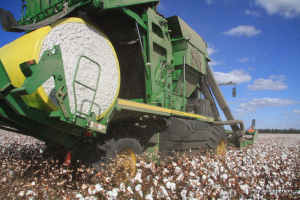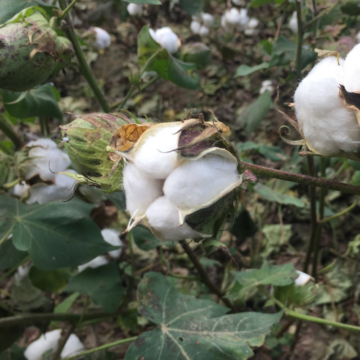 Tonight I was asked to answer a question about cotton on Quora and I decided to go ahead and post my reply here on the blog too since I had already taken the time to write it all up. 🙂 The question was “How is cotton picked nowadays?” The answer I gave them follows with a few minor modifications.
Tonight I was asked to answer a question about cotton on Quora and I decided to go ahead and post my reply here on the blog too since I had already taken the time to write it all up. 🙂 The question was “How is cotton picked nowadays?” The answer I gave them follows with a few minor modifications.
There are a few ways that cotton is currently harvested.
In the US the two predominant ways to harvest cotton on farms is either using 1) mechanical cotton pickers or 2) using a mechanical cotton stripper. A cotton picker pulling the lint from the plants bracts that hold it on and leaves the rest of the plant as is. This is what is used in the Southeast, Mid-South and Far West (CA & AZ). Some areas of Texas and Oklahoma use pickers but on the High Plains (Lubbock & Amarillo, Texas are two of the bigger cities in that area) cotton strippers are commonly used. Strippers pull more of the plant into the equipment which means there will be additional cleaning or ginning needed. Its interesting to note that within the cotton picker segment there are some differences in machinery and labor requirements. The latest state of the art pickers include the ability to compact cotton on-board, pressing it into a module as it rolls through the field. These pickers can pick six rows of cotton at a time and are rapidly becoming the market standard in the US as they eliminate the need to a separate module builder and other equipment and people to run those. Most of the more developed or advanced agricultural systems in cotton producing nations use pickers so its similar in Australia and Brazil.
 There are a few photos & videos of cotton harvest on my blog if you’d like to take a look.
There are a few photos & videos of cotton harvest on my blog if you’d like to take a look.
- a bit of recollection from a friend who drove a one row cotton picker in the 1970s as well as a video of one of the new on-board moduling pickers that produces rectangular modules.
- another current day picker running through the field and shows you what the round modules look like.
- shows you what I mean by moduling that’s needed with pickers that do not have the on-board moduling system and shows how those modules are transported.
 Hand-harvesting is still the standard in many other countries and you can see that done in many areas of Turkey, India, China, Africa, etc. In these places, the people who harvest are still picking cotton the way it was done in the US many decades ago. Usually people are paid per pound or kilo of cotton harvested. Cotton in these countries may be brought to the gin in trucks, still in bags or in wagons pulled by tractors. (The photo at right is from a trip I took to Turkey and ended up visiting farms during my vacation.)
Hand-harvesting is still the standard in many other countries and you can see that done in many areas of Turkey, India, China, Africa, etc. In these places, the people who harvest are still picking cotton the way it was done in the US many decades ago. Usually people are paid per pound or kilo of cotton harvested. Cotton in these countries may be brought to the gin in trucks, still in bags or in wagons pulled by tractors. (The photo at right is from a trip I took to Turkey and ended up visiting farms during my vacation.)
I can also tell you that I have picked cotton in the very recent past here in the US but that was part of research efforts where researchers pick individual plants or even selected bolls for testing and breeding purposes.
——————————–
I have a lot of posts in a Cotton 101 series as well as even more tagged as cotton. Feel free to add topics to my blogging list! I sometimes wonder what others would like to know about my favorite fiber crop!





This is so fascinating! I think it would be awesome to spend a couple of seasons on a farm! Kids should have to work for a year to learn good work ethics and responsibility!!
Well, if you want your kids to get a little exposure to farming, I could help you find farms close by where they could lend a hand or at least learn about the hardwork involved in farming!
Great post. I was out in the country last month with my four girls, ages 8, 10, 10 and 11, and a farmer saw us picking cotton from an already harvested field and asked if we wanted to see a field being harvested at that moment. My girls and I were all for it, so we went down the road about a mile and were able to learn first hand.
There’s nothing like seeing something in person to learn how it’s done, and I got some great photos. I’ve also been able to teach them about why the cotton gin was so significant by simply having them try to pull the seeds from a few bolls of cotton, so they can learn how time consuming it can be.
I agree! First-hand experiences stick with you in a way reading just doesn’t! Glad you enjoyed the time out with your girls!
Good to see the informative post, I am from Pakistan, the 4th largest cotton producing country in the world. In Pakistan 100% cotton is handpicked, and the job is done by ladies, usually they are from one family, the land lord or the farmer send their tractor trolley to bring them for picking in the morning and before dusk they provide the ride to back their home. The wages vary from area to area, it is about Rs. 8.00 per kilo now a day, but it is also done on share bases like 10th share will go to pickers. It really looks great when you see ladies in colorful dress picking the white gold. Some time ladies do have small babies with them and they lay their babies under the nearby shade of a tree and pick cotton. Before, GM cotton, it used to sprayed with insecticide a lot and there were some cases of poisoning of ladies or their young one, but not anymore.
Since ladies are paid by weight, and no agreement on quality, the ladies less care about the trash admixture and is one of the major concern of our cotton and textile industry.
Cotton is a lovely crop, it provide clothing, oil for human consumption, cake for animal and poultry feed, sticks for rural house hold fuel, and left over bolls for grazing animals. None of plant part is wasted.
Thank you for sharing some of your thoughts on cotton. It certainly is a fantastic crop! It is amazing to me how much biotech is improving the lives of farmers who use it.
I’ve seen the problems with paying by weight… ginners have a tough time with the trash and contaminants.
Are there any cotton farms in the UK? His can a novice get involved with cotton harvesting?
None that I know of. In fact, I understand the only cotton farms in Europe are in Greece, Spain and Turkey.
Hold up, Africa’s not a country.
Right and there are quite a few cotton-producing countries on the continent. I think I was talking about countries and various areas both simultaneously so it is a bit confusing. I will edit so it is clearer. Thanks for noticing!
Who said it was?
How long does it take to harvest an acre of cotton?
Can I please thank you on this whole cotton series? I am writing an assessment about denim right now and your blog is a great help!
Glad to hear it! Let me know if you see gaps I should fill!